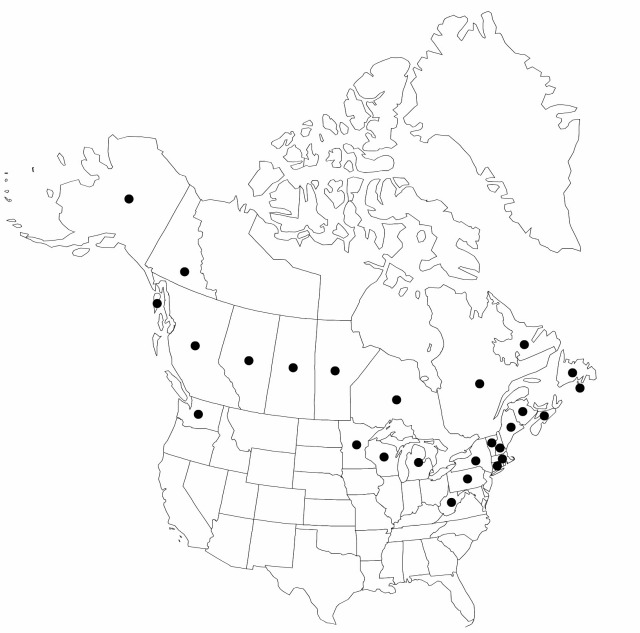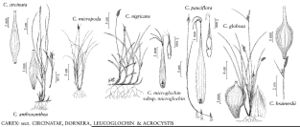Carex pauciflora
Fl. Scot. 2: 543, plate 6, fig. 2. 1777.
Rhizomes 0.2–10 cm, 0.6–1.2 mm in diam. Culms arising singly or in loose tufts of 2–6 (–12), 10–40 (–60) cm, apically slightly scabrous. Leaves: proximal 1–4 reduced to bladeless or nearly bladeless sheaths; foliage leaves 1–2 (–3) per culm; ligules about as wide as long; blades mostly 1–3 (proximal blade) or 5–13 (distal) cm × 0.5–1.6 mm. Spike consisting of slender terminal cone of (1–) 2–4 staminate flowers and (1–) 2–6 (–7) pistillate flowers, 3–10 (often 5–8) × 2–8 (immature fruit) or to 17 (mature fruit) mm. Pistillate scales 3.7–5.9 mm, wider than and 2/3 length of perigynia. Staminate scales closely appressed. Perigynia light green, becoming straw colored or pale-brown, lance-subulate to narrowly elongate-oblong, (5–) 5.9–7.8 × 0.7–1.1 mm, long-tapering; beak indistinct; rachilla vestigial. Achenes 2–2.4 × 0.8–1 mm; style exserted 0.2–1.3 mm beyond orifice of beak. 2n = ca. 74, 76.
Phenology: Fruiting summer–fall (late May–early Sep).
Habitat: Sphagnum bogs and acidic peat (damp mossy tundra, dryish heaths, alpine quagmires, moist forests), usually on open mats, also in partial shade of conifers
Elevation: 0–1500 m
Distribution

St. Pierre and Miquelon, Alta., B.C., Man., N.B., Nfld. and Labr., N.S., Ont., Que., Sask., Yukon, Alaska, Conn., Maine, Mass., Mich., Minn., N.H., N.Y., Pa., Vt., Wash., W.Va., Wis., n Eurasia
Discussion
Carex pauciflora is sometimes confused with C. microglochin, though C. pauciflora is easily distinguished by the lack of an evident rachilla. Compared to C. microglochin, the shoots of C. pauciflora tend to be more definitely tufted, the culms are more sharply 3-angled and roughened distally, and the achenes fill less of the perigynia. Carex pauciflora has a catapult dispersal mechanism (E. E. Hutton 1976) in contrast to the putative clinging mechanism of C. microglochin and presumably C. camptoglochin V. I. Kreczetowicz and C. parva Nees (see comments under the previous species). Dispersal by animals is possible for C. pauciflora as well. People walking through bogs may find perigynia attached to their clothing (L. Brouillet, pers. comm.).
Selected References
None.
Lower Taxa
"shortened" is not a number.
